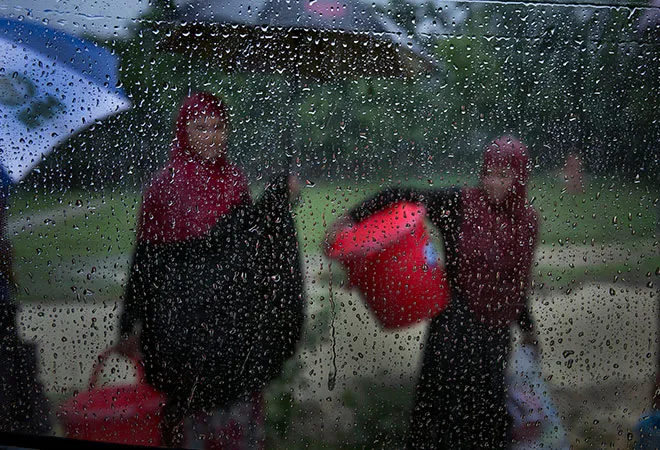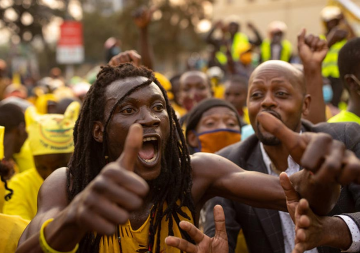
Life within the Rohingya camps at Cox’s Bazar district is becoming quite frantic as multiple natural disasters strike one of the most vulnerable communities in a heavily populated area. As is known, the COVID-19 situation is extremely delicate since the confirmation of 29 infections within the camp areas. The minimal health capacities arranged by the government, along with the humanitarian agencies, are now at play to control the already complex situation. Followed by this, two bouts of fire incidents have destroyed hundreds of shelters and shops within Kutupalong camp area — threatening hygiene facilities and leading to more cramped spaces.
On top of this, the recent Amphan cyclone has shattered more shelters, blocked drains, damaged water points, latrines and bridges. Flooding and small landsides has also occurred. Fortunately, no casualties or deaths have been reported yet. Humanitarian partners are on standby to ensure access to information, temporary shelter, food, safe drinking water and other vital services on a need-based basis.
With the camp areas affected by COVID-19, fire and Amphan, it is important to assess the ground preparedness to tackle the upcoming monsoon season which could further disrupt the WASH and shelter facilities built to tackle COVID-19 situation.
The minimal health capacities arranged by the government, along with the humanitarian agencies, are now at play to control the already complex situation.
The monsoon season is Bangladesh ranges from June, to the end of October. This is a difficult period within the Rohingya camps; the area is filled with shacks made of bamboo and tarpaulin with communal water points and latrines. Moreover, few settlements are placed on hilly terrains. According to a UNICEF report, a risk assessment in 2018 January identified that about 100,000 displaced people were living in high risk areas which were exposed to landslides.
According to the 2019 Inter Sector Coordination Group (ISCG) report around 83,517 Rohingyas were affected, with 17,127 displaced and about 98,750 sanitation facilities either devastated or malfunctioning in the monsoon season.
While efforts were made this year to replace or repair shelters, and construct pathways and bridges, the current pandemic has deterred existing plans. Measures in place for monsoon preparations have been heavily affected due to the deferral of Disaster Risk Reduction (DRR) efforts, such as, slope stabilisation work, improvement of sludge and drainage systems and shifting of Rohingyas from areas at high risk of flooding and landslides.
In spite of the shortcomings, humanitarian organisations are trying to address the situation by distributing tie-down kits to protect shelters against high winds. Additionally, the Emergency Preparedness and Response Teams (EPRT) are on standby, to operate in situations of extreme weather conditions. Hygiene promotion, hygiene kit distribution, water and sanitation activities, construction of health and water and sanitation (WASH) infrastructure are continuing. Online training sessions are being held to equip individuals with better response capacities towards the monsoon and cyclone seasons, amidst this pandemic.
Measures in place for monsoon preparations have been heavily affected due to the deferral of Disaster Risk Reduction efforts.
Regardless of such efforts, the recent cyclone Amphan has affected some of the mechanisms in place. Prior to the cyclone around 44, 972 WASH facilities and buildings were disinfected. Post Amphan, few amenities have been either partially affected or permanently damaged. For instance, latrines or water points have been severely dented — thus polluting water and disturbing sanitation and hygiene conditions.
Disruption of WASH facilities raises a number of public health concerns. Acute watery diarrhea, acute respiratory infection, and unexplained fever are quite high among the displaced people. The presence of acute malnutrition, owing to food insecurity within the camp areas, coupled with such diseases enhances the COVID-19 situation further. The upcoming monsoon season will add to the dilemma, if rapid measures are not implemented successively.
The destruction of shelters by the recent fire or cyclone needs to be compensated with building new ones using durable bamboo sticks, elevated on small stilts, so that water can flow underneath it. The humanitarian agencies have been constructing such settlements before the lockdown measures took place. Delay on this may increase chances of COVID-19 infections, since maintaining social distancing and self-isolation within the camp areas remain inconsistent. In all probability, efforts to restore the WASH facilities needs to commence swiftly, along with resumption of disinfecting buildings and other services to ensure safety of the displaced people.
Prior to the cyclone around 44, 972 WASH facilities and buildings were disinfected. Post Amphan, few amenities have been either partially affected or permanently damaged.
To tackle such situations, ensuring proper flow of funds is crucial. The 2020 Joint Response Plan has aimed to mobilise $877 million to guarantee access to food, clean water and sanitation, shelter and other urgent assistance, for the wellbeing of the displaced people. However, as we reach the mid-year mark, less than 20 percent has been received. The lack of adequate funding during such trying times risks compromising vital services and the health and wellbeing of both the Rohingya and neighbouring community. The international community in this regard, must rejuvenate its financial support to ease the stress on Bangladesh.
On the health front, since the testing for COVID-19 has increased, the cases are likely to amplify. Thus, need for arranging more hospital beds and proper isolation facilities will be essential. The government, along with the humanitarian agencies, has arranged for 1,900 beds and 7 isolation centres. However, given the number of displaced people, these numbers remain paltry. Moreover, to ensure secured preparedness measures, adequate personal protective equipment (PPE) is vital, given the enormity of the demands. The large-scale procurement and distribution of PPE is fundamental to ensure that the virus does not take hold or spread hastily.
The current condition has presented a novel scenario where innovative frameworks need to be designed to safeguard people from the twin threats of COVID-19 and the upcoming monsoon season. As of now, a proper monsoon response — integrating COVID-19 measures — has not yet been framed by the government. In this context, a proper framework may help provide a better strategy for improved response, as well as mitigation, in the days to come.
The views expressed above belong to the author(s). ORF research and analyses now available on Telegram! Click here to access our curated content — blogs, longforms and interviews.




 PREV
PREV


